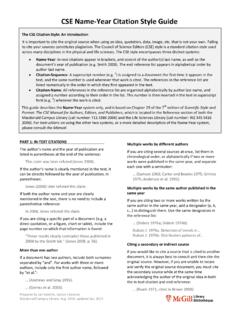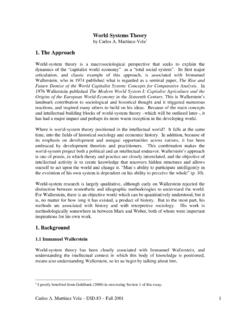Transcription of From Transactional to Iransformational ... - McGill University
1 Transformational leaders inspire, energize, and intellectually stimulate their employees. The author argues that through training, managers can learn the techniques and obtain the qualities they need to become transformational leaders. From Transactional to Iransformational Leadership: Learning to Share the Vision BERNARD M. BASS. ^^ir jEdmund Hillary of Mount Everest flooring, the seaman decided he would retuijn \ fajne liked to tell a story about one of home. Scott later became one of the victims ^J Captain Robert Falcon Scott's earlier at- of his own inadequacies as a leader in his 1911. tempts, from 1901 to 1904, to reach the South race to the South Pole. Shackleton went qn Pole. Scott led an expedition made up of men to lead many memorable expeditions; once, from thb Royal Navy and the merchant ma- seeking help for the rest of his party, who rine, as jwell as a group of scientists.
2 Scott had were stranded on the Antarctic Coast, he considel'able trouble dealing with the mer- journeyed with a small crew in a small open chant n|arine personnel, who were unaccus- boat from the edge of Antarctica to Souilh tomed ip the rigid discipline of Scott's Royal Georgia Island. Navy. S|:ott wanted to send one seaman home because he would not take orders, but the sea- man refused, arguing that he had signed a LEADERSHIP TODAY. contract and knew his rights. Since the sea- man wds not subject to Royal Navy discipli- Most relationships between supervi- nary action, Scott did not know what to do. sors and their employees are quite different Then Ernest Shackleton, a merchant navy of- today. Few managers depend mainly on their ficer in $cott's party, calmly informed the sea- legitimate power, as Scott did, or on their man th^t he, the seaman, was returning to coercive power, as Shackleton did, to per- Britain.
3 Again the seaman refused and suade people to do as they're told. Rather, Shackle^on knocked him to the ship's deck. managers engage in a transaction with their After ar^other refusal, followed by a second employees: They explain what is required of 19. them and what compensation they will re- ceive if they fulfill these requirements. A shift in management style at Xerox's Reprographic Business Group (RBG) pro- vides a good example. In the first step toward establishing management in which managers take the initiative and show consideration for others, 44 specific, effective management be- haviors were identified. Two factors that char- acterize modern leadership were found in many of these behaviors. One factor initial- ing and organizing work concentrates on ac- Bernard M. Bass is Distinguished Profes- complishing the tasks at hand. The second sor of Management and director of the factor showing consideration for employ- Center for Leadership Studies at the State ees focuses on satisfying the self-interest of University of New York at binghamton .
4 He those who do good work. The leader gets has held faculty positions at the univer - things done by making, and fulfilling, prom- sity of Rochester, the University of Pitts- burgh, the University of California at ises of recognition, pay increases, and ad- Berkeley, and Louisiana State University . vancement for employees who perform well. He is a fellow of the Academy of Manage- By contrast, employees who do not do good ment and the Society for Industrial/Orga- work are penalized. This transaction or ex- nizational Psychology, executive editor of change this promise and reward for good per- The Leadership Quarterly, and a member of the executive committee of the Interna- formance, or threat and discipline for poor tional Association of Applied Psychology performance characterizes effective leader- and past president of its division of orga- ship.
5 These kinds of transactions took place nizational psychology. Bass has performed in most of the effective 44 leadership be- research, led management development haviors identified at Xerox's RBG. This kind programs, conducted workshops, and lec- of leadership, which is based on transactions tured on leadership in more than 30 coun- tries; his books have been translated into between manager and employees, is called many languages. He has led a worldwide "transactiona! leadership.". management research and training pro- In many instances, however, such trans- gram sponsored by the Ford Foundation. Bass holds a from Ohio State actional leadership is a prescription for medi- University . His latest work. The Bass and ocrity. This is particularly true if the leader Stogdill Handbook of Leadership (Third relies heavily on passive management-by-ex- Edition) (Free Press, 1990) reviews and ception, intervening with his or her group integrates leadership theory, research, only when procedures and standards for ac- and applications from the social, political, complishing tasks are not being met.
6 My col- and behavioral sciences. leagues and I have arrived at this surprising but consistent finding in a number of research analyses. Such a manager espouses the popu- lar adage, "If it ain't broken, don't fix it." He or she stands in back of the caboose of a mov- ing freight train and says, "Now I know v/here we are going." This kind of manager may use 20. disciplinary threats to bring a group's perfor- degree of trust and confidence in them. Char- mance up to standards a technique that is ismatic leaders inspire and excite their errj- ineffective and, in the long run, likely to be ployees with the idea that they may be able counterproductive. to accomplish great things with extra effort. Moreover, whether the promise of re- Further, transformational leaders are individ- wards or the avoidance of penalties motivates ually considerate, that is, they pay close atteiv the employees depends on whether the leader tion to differences among their employee?
7 ;. has control of the rewards or penalties, and they act as mentors to those who need heljp'. on whether the employees want the rewards to grow and develop. Intellectual stimulatio jn. or fear the penalties. In many organizations, of employees is a third factor in transforma- pay increases depend mainly on seniority, tional leadership. Intellectually stimulating and promotions depend on qualifications and leaders are willing and able to show their em- policies about which the leader has little to ployees new ways of looking at old problems, say. The breaking of regulations rnay be the to teach them to see difficulties as problerqs main cause of penalties. Many an executive to be solved, and to emphasize rational solu- has found his or her hands tied b3^ contract tions. Such a leader was Lorenz Iversen, a. provisions, organizational politics, and in- former president of the Mesta Machine Coni- adequate resources.
8 Pany, who said to his employees, "We got this job because you're the best mechanics in the world!" He practiced management-by-walli- TRANSFORMATIONAL LEADERSHIP ing-around and stimulated the developmetjt of many of Mesta's patented inventions. He is Superior leadership performance trans- remembered for instilling pride and commit- formational leadership occurs when leaders ment in his emploj^es. broaden and elevate the interests of their em- ployees, when they generate awareness and acceptarice of the purposes and mission of the THE BIG PAYOFF. group, and when they stir their employees to look beyond their own self-interest for the Managers who behave like transform<i- good of the group. Transformational leaders tional leaders are more likely to be seen by achieve these results in one or more ways: their colleagues and employees as satisfjdng They may be charismatic to their followers and effective leaders than are those who be- and thus inspire them; they may meet the have like Transactional leaders, according tp emotional needs of each employee; and/or their colleagues', supervisors', and employees'.
9 They may intellectually stimulate employees. responses on the Multifactor Leadership Queii- Exhibit 1 lists the characteristics of transfor- tionnaire (MIQ). Similar results have beeh mational and Transactional leadership; these found in various organizational settings. Lead- listings are based on the findings of a series ers studied have come from an extremely of surveys and on clinical and case evidence. broad variety of organizations: chief executive Attaining charisma in the eyes of one's officers and senior and middle level managers employees is central to succeeding as a trans- in business and industrial firms in the Unite^l formational leader. Charismatic leaders have States, Canada, Japan, and India; research great power and influence. Employees want and development project leaders; America^, to identify with them, and they have a high Canadian, and British Army field grade offi- 21.
10 Exhibit 1. CHARACTERISTICS OF TRANSFORMATIONAL AND Transactional LEADERS. TRANSFORMATIONAL LEADER. Charisma: Provides vision and sense of mission, instills pride, gains respect and trust. Inspiration: Communicates high expectations, uses symbols to focus efforts, expresses important purposes in simple ways. Intellectual Stimulation: Promotes intelligence, rationality, and careful problem solving. Individualized Consideration: Gives personal attention, treats each employee individually, coaches, advises. Transactional LEADER. Contingent Reward: Contracts exchange of rewards for effort, promises rewards for good performance, recognizes accomplishments. Management by Exception (active): Watches and searches for deviations from rules and standards, takes corrective action. Management hy Exception (passive): Intervenes only if standards are not met.










